
In the five national Liberty Loan campaigns to finance the war, Knox County not only went "over the top," but in each of them its citizens bought more bonds than the government asked of them. The total subscriptions in five loans were approximately $13,500,000, though the county's quota was only slightly in excess of $10,000,000. Add to these subscriptions more than $2,000,000 invested in war savings stamps and the loans from Knox Countians to the federal government for the prosecution of the war reached the huge sum of more than $15,000,000.
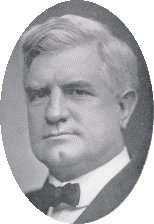 The
sale of so many government securities was made possible by the splendid
selling organization built up and perfected in each succeeding campaign
by Hon. T. Asbury Wright, who was chairman for Knox County
in each of the five loans. He was the only county chairman in the
Sixth Federal Reserve District who served consecutively through all of
these campaigns. He virtually gave up his private business during
them to further the sale of the bonds. Thanks to his constructive,
organizing ability, backed by liberal space contributed by patriotic individuals,
firms and by the newspapers themselves, the vital necessity of participating
in the loans was carried to every home in the city and county.
The
sale of so many government securities was made possible by the splendid
selling organization built up and perfected in each succeeding campaign
by Hon. T. Asbury Wright, who was chairman for Knox County
in each of the five loans. He was the only county chairman in the
Sixth Federal Reserve District who served consecutively through all of
these campaigns. He virtually gave up his private business during
them to further the sale of the bonds. Thanks to his constructive,
organizing ability, backed by liberal space contributed by patriotic individuals,
firms and by the newspapers themselves, the vital necessity of participating
in the loans was carried to every home in the city and county.
Mr. Wright was assisted by an executive committee composed of the presidents of the Knoxville banks -- William S. Shields, Frank L. Fisher, S. B. Luttrell, Joseph P. Gaut, E. E. McMillan, J. Allen Smith, Hu M. Johnston, W. H. Sterchi, Charlton Karns, J. J. Ashe, and, during the Fourth and Fifth Loans, Robert S. Young, president of the American National Bank. Samuel V. Carter, who was zone chairman for 20 of the upper East Tennessee counties, gave his assistance and support in each of the campaigns. These men, together with other officials of their banks, did yeoman service.
In the Fourth and Fifth Loans, which were considerably the largest, Mr. Wright organized a ward and district system for the purpose of getting in contact with every citizen in the city and county. Knoxville was divided into four divisions, while the county constituted a fifth. Matt G. Thomas was placed in command of the First Division; G. L. Price of the Second; J. L. Deaver of the Third; E. R. Wade of the Fourth; while John L. Boyd had charge of the county, or Fifth Division. Each general had under him a colonel, lieutenant-colonel, captain and several lieutenants. These officers in the various divisions, wards and precints were:
| Division No. 1 | Division No. 2 | |||
| Richard K. Gibson | Colonel | Charles H. Harvey | Colonel | |
| Floyd Haun | Lieutenant-Colonel | W. R. Johnson | Lieutenant-Colonel | |
| U. D. Beeler | Captain, 1st Ward | James E. Hickman | Captain, 5th Ward | |
| W. S. Hall | Captain, 2nd Ward | Edgar George | Captain, 6th Ward | |
| James E. Thompson | Captain, 3rd Ward | George Chandler | Captain, 7th Ward | |
| Charles M. Thomas | Captain, 4th Ward | Mel Miller | Captain, 8th Ward | |
| Edward Briscoe | Captain, 12th Ward | J. C. White | Captain, 13th Ward | |
| J. Park Vestal | Captain, 25th Ward | B. L. Johnson | Captain, 14th Ward | |
| Chas. C. Rutherford | Captain, 26th Ward | |||
| Division No. 3 | Division No. 4 | |||
| V. N. Hacker | Colonel | E. H. Scharringhaus | Colonel | |
| Sam V. Minskey | Lieutenant-Colonel | Jesse E. Miller | Lieutenant-Colonel | |
| James Waters | Captain, 9th Ward | James M. Rule | Captain, 11th Ward | |
| C.
M. Mitchell and W. W. Woodruff, Jr. |
Captain, 10th Ward | Edwin McLemore | Captain, 15th Ward | |
| C. E. Randall | Captain, 22nd Ward | J. W. Beam | Captain, 16th Ward | |
| Arthur Groves | Captain, 24th Ward | Dr. A. D. Albright | Captain, 17th Ward | |
| Boyd Hicks | Captain, 18th Ward | |||
| Rev. James C. Shipe | Captain, 19th Ward | |||
| Hal H. Clements | Captain, 21st Ward | |||
| W. R. Ryno | Captain, 23rd Ward | |||
| Division No. 5 | ||||
| C. H. Baker | Colonel | Dr. J. B. Parker | Community Captain, Inskip | |
| Powell Smith | Lieutenant-Colonel | W. B. Cobb | Community Captain, Karns | |
| W. H. Moore | Community Captain, Asbury | Sam Johnson | Community Captain, Kimberlin Heights | |
| S. O. Houston | Community Captain, Anderson | Hugh R. McElvin | Community Captain, Mascot | |
| Dr. H. M. Lee | Community Captain, Bearden | R. E. Masterson | Community Captain, Mt. Olive | |
| P. J. Gambill | Community Captain, Carter's | Mack Haynes | Community Captain, New Hopewell | |
| H. B. Walker | Community Captain, Gallaher's | John Tedford | Community Captain, Paulette | |
| Dr. A. L. Foster | Community Captain, Corryton | Dr. G. N. Harrell | Community Captain, Powell Station | |
| Adam Phillips | Community Captain, Farragut | Dr. J. W. Drinnen | Community Captain, Riverdale | |
| A. F. Mahan | Community Captain, Fountain City | R. R. Rule | Community Captain, Stock Creek | |
| R. H. George | Community Captain, Gibb's | J. H. Bradshaw | Community Captain, Third Creek | |
| George B. Hardin | Community Captain, Hardin Valley | George O. Cardwell | Community Captain, Washington | |
| R. Ledgerwood | Community Captain, Hall's | A. C. Grinn | Community Captain, Smithwood | |
| S. J. Messamore | Community Captain, Heiskell | John Brown | Community Captain, Thorn Grove | |
In the Fourth and Fifth Loans especially, the commercial travelers of Knoxville did splendid service. Their two organizations, the T. P. A. and the U. T. C., under the leadership of E. W. Neal, Frank May, J. B. Criswell and W. D. Hogan, worked effectively and harmoniously with the Liberty Loan organization built up by Mr. Wright. As experienced salesmen they reached large numbers of men and women and sold thousands of dollars worth of the bonds.
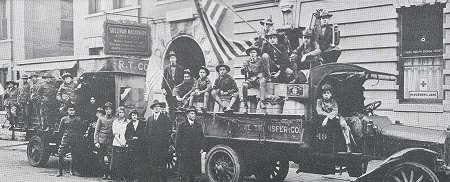 As
a further means of reaching every home and approaching every man and woman
in Knox County, Mr. Wright brought two other strong agencies
to bear in the latter campaigns. These organizations were the Four
Minute Men and the Boy and Girl Scouts. The Four Minute Men campaigned
the theatres, moving picture houses and other places of assembly in the
city while in the county they stumped every village and cross roads. The
Boy and Girl Scouts, under the able leadership of John M. Gore,
Scout Executive, proved effective salesmen in all the campaigns in which
they took part. [Photo at left shows Knoxville Boy
Scouts. "These boys rendered magnificent service in all local
campaigns during the war."]
As
a further means of reaching every home and approaching every man and woman
in Knox County, Mr. Wright brought two other strong agencies
to bear in the latter campaigns. These organizations were the Four
Minute Men and the Boy and Girl Scouts. The Four Minute Men campaigned
the theatres, moving picture houses and other places of assembly in the
city while in the county they stumped every village and cross roads. The
Boy and Girl Scouts, under the able leadership of John M. Gore,
Scout Executive, proved effective salesmen in all the campaigns in which
they took part. [Photo at left shows Knoxville Boy
Scouts. "These boys rendered magnificent service in all local
campaigns during the war."]
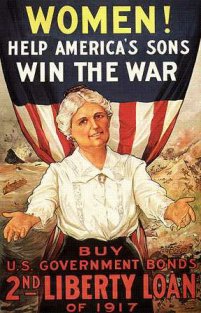 The
first loan campaign was ushered in the latter part of May, 1917. There
was little formal organization for the sale of bonds. The subscriptions
were largely from the wealthy citizens and the banks. They were
received through the banks up until the final days of the campaign when
eighteen teams of Boy Scouts took the field and sold $153,000 of the bonds
by the end of the drive on June 15. No quota was fixed definitely,
but the total voluntary subscriptions amounted to $1,246,555.
The
first loan campaign was ushered in the latter part of May, 1917. There
was little formal organization for the sale of bonds. The subscriptions
were largely from the wealthy citizens and the banks. They were
received through the banks up until the final days of the campaign when
eighteen teams of Boy Scouts took the field and sold $153,000 of the bonds
by the end of the drive on June 15. No quota was fixed definitely,
but the total voluntary subscriptions amounted to $1,246,555.
The second loan campaign four months later, beginning October 1 and continuing until October 27, saw the creation of the first real bond sales organization. In addition to Mr. Wright as chairman, Jos. P. Gaut was elected vice-chairman, and Mrs. Joseph H. Anderson was made head of the woman's committee. J. Pike Powers, Jr., was named director of the Four Minute Men, and John M. Gore organized the Boy Scouts for a more intensive campaign. The quota assigned to Knox County was $1,200,000. The sales amounted to $1,838,400, almost fifty per cent more than the quota assigned.
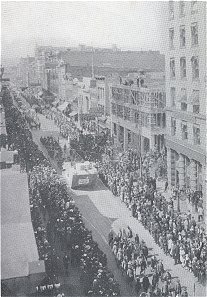 [Photo
at left - "Boosting Liberty Bonds. Boy Scout tank in big civic
demonstration for Third Liberty Loan, Saturday, August 6, 1918.] The
third loan was equally as great a success. Practically the same
organization, which had been built up in the previous campaigns, was used
to float this one, which began April 6, 1918, and closed on May 4. Mr.
Wright continued his work as director-general of the whole campaign,
but Mrs. John W. Hudson succeeded Mrs. Anderson
as general chairman of the woman's department. Mrs. W. C.
Ross was named to push the sale of bonds among the women of the
county districts. The "Minute Women" also entered the
campaign, making one minute speeches daily on Gay Street and at all public
meetings. Mrs. E. T. Sanford, assisted by Mrs.
Herbert Hall, was in charge of this phase of the work, while
Harry R. Ryder succeeded J. Pike Powers, Jr.,
as director of the Four Minute Men campaign. Ten teams of men and
the same number of women canvassed the city and county in selling bonds.
The women alone reported sales of about $900,000. The total
subscriptions were $2,417,100. The quota was only $2,000,000. The
most encouraging feature of this campaign was the number of people who
participated in it. Final figures showed that 12,880 bought bonds.
[Photo
at left - "Boosting Liberty Bonds. Boy Scout tank in big civic
demonstration for Third Liberty Loan, Saturday, August 6, 1918.] The
third loan was equally as great a success. Practically the same
organization, which had been built up in the previous campaigns, was used
to float this one, which began April 6, 1918, and closed on May 4. Mr.
Wright continued his work as director-general of the whole campaign,
but Mrs. John W. Hudson succeeded Mrs. Anderson
as general chairman of the woman's department. Mrs. W. C.
Ross was named to push the sale of bonds among the women of the
county districts. The "Minute Women" also entered the
campaign, making one minute speeches daily on Gay Street and at all public
meetings. Mrs. E. T. Sanford, assisted by Mrs.
Herbert Hall, was in charge of this phase of the work, while
Harry R. Ryder succeeded J. Pike Powers, Jr.,
as director of the Four Minute Men campaign. Ten teams of men and
the same number of women canvassed the city and county in selling bonds.
The women alone reported sales of about $900,000. The total
subscriptions were $2,417,100. The quota was only $2,000,000. The
most encouraging feature of this campaign was the number of people who
participated in it. Final figures showed that 12,880 bought bonds.
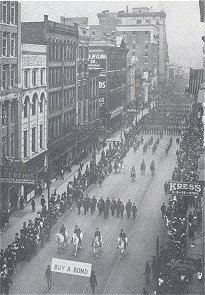 [Photo
at right - "Fourth Liberty Loan. Head of big parade marching
north on Gay Street in Knoxville, September 28, 1918."] The
fourth loan in the fall of 1918, when our armies were making deep gains
daily and a wave of victorious exaltation was sweeping the whole country,
outdistanced all the others in the enthusiasm it provoked and the ease
with which nearly as many bonds were sold as in the three previous campaigns
combined. Page after page of advertising, splendid war posters,
furnished by the national loan organization, letters, personal appeals,
exhortations from every platform in Knox County by the very best speakers,
all these agencies, with the psychology of the moment of approaching victory,
made this loan tremendously popular.
[Photo
at right - "Fourth Liberty Loan. Head of big parade marching
north on Gay Street in Knoxville, September 28, 1918."] The
fourth loan in the fall of 1918, when our armies were making deep gains
daily and a wave of victorious exaltation was sweeping the whole country,
outdistanced all the others in the enthusiasm it provoked and the ease
with which nearly as many bonds were sold as in the three previous campaigns
combined. Page after page of advertising, splendid war posters,
furnished by the national loan organization, letters, personal appeals,
exhortations from every platform in Knox County by the very best speakers,
all these agencies, with the psychology of the moment of approaching victory,
made this loan tremendously popular.
The central sales organization again was headed by Mr. Wright, while Mrs. Samuel G. Shields made an effective chairman of the Knox County woman's committee. The subcommittees were the same as in the preceding loan. Ministers gave their support from the pulpit, all kinds of street advertising were employed, a street fair, in which loan booths were established, was responsible for the sale of several hundred thousand dollars' worth of bonds, and scores of speakers toured the mills and factories, the stores and the rural districts for the loan. Boy and Girl Scouts canvassed both homes and streets. The schools organized bond clubs. The commercial travelers gave of their time unsparingly. In the closing days, a "dynamite" committee, composed of influential citizens, made large sales that could not otherwise have been made.
The flood of subscriptions on the last day of the campaign fairly swamped the banks, which received them. The quota of $3,685,000, which had seemed impossible to reach when the campaign started, was far surpassed. When all the subscriptions had been counted, it was found that the sales amounted to $4,858,950. The number of subscribers was 23,985. Practically one out of every four men, women and children in the city and county had bought a bond of some denomination.
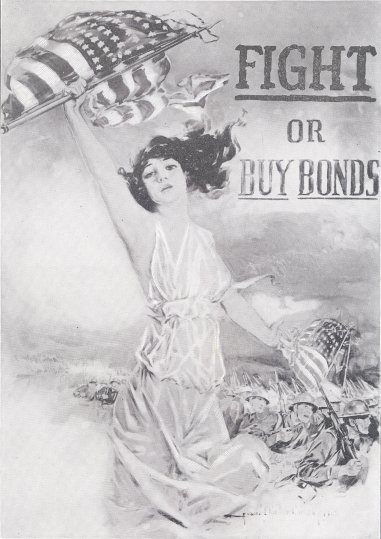 Sales
of the notes of the Fifth, or Victory Loan, as it was called, was much
harder than in the preceding campaigns, when war was still being waged.
The heat of a great victory had cooled, thousands of soldiers were
returning, and, furthermore, a great many of those who had made actual
personal sacrifice to buy in the earlier campaigns, did not feel equal
to the burden which the final one would entail. There was a wide-spread
feeling also that the money interests of the country, which did not subscribe
early in the campaign, would more than take the loan in the final hours
of the drive because of the high rate of interest and the exemption from
taxation, which this loan afforded.
Sales
of the notes of the Fifth, or Victory Loan, as it was called, was much
harder than in the preceding campaigns, when war was still being waged.
The heat of a great victory had cooled, thousands of soldiers were
returning, and, furthermore, a great many of those who had made actual
personal sacrifice to buy in the earlier campaigns, did not feel equal
to the burden which the final one would entail. There was a wide-spread
feeling also that the money interests of the country, which did not subscribe
early in the campaign, would more than take the loan in the final hours
of the drive because of the high rate of interest and the exemption from
taxation, which this loan afforded.
The quota set for Knox County was $2,832,450. When the subscriptions reached about $1,500,000, the sales fell off and popular interest and participation lagged. The "dynamite" committee, composed of teams of two men each who had access to the sources of wealth in the city and county, again was called into action and, with five hours of vigorous canvassing among the larger interests, the quota was almost reached. The banks underwrote the rest, while late popular subscriptions carried the total to approximately $3,100,000.
The organization was somewhat different in this campaign. Mr. Wright again gave his time and services as chairman of the central committee, but Mrs. James H. Anderson, who had directed the woman's share of the work in the second loan, succeeded Mrs. Shields, who had gone out of the city, as chairman of the Knox County woman's committee. Henry Hudson and Mrs. W. P. Davis were directors of the men's and women's five minute speakers, while John R. Williams and Mrs. Walter Luttrell were in charge of the publicity for the loan.
[ Return to Knox County Genealogy Military Page ]
[ Return to Knox County Genealogy Main Page ]
Except as noted, all HTML code and graphics in the URL path [http://www.knoxcotn.org/military/wwi/] were created by and copyrighted 2001-2003 to Billie R. McNamara. All rights reserved. Please direct all questions and comments to Ms. McNamara.This page was last updated January 2, 2004. Visitor